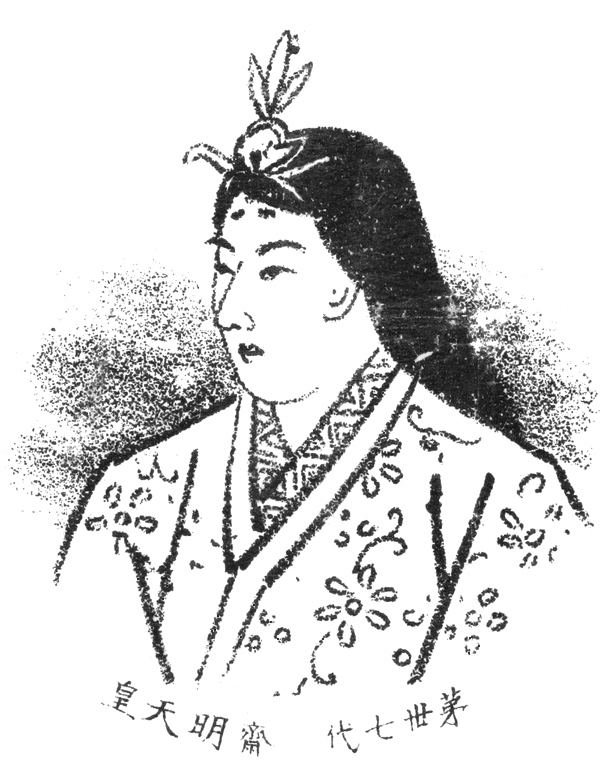Name Empress Kogyoku | Successor Emperor Kotoku Role Monarch | |
 | ||
Reign January 25, 642 – June 14, 645 Coronation January 25, 642(642-01-25) (aged 48) Reign January 3, 655 - July 24, 661 Coronation January 3, 655(655-01-03) (aged 61) Children Emperor Tenji, Emperor Tenmu Parents Prince Chinu, Princess Kibitsu-Hime Grandchildren Princess Nukata, Empress Jito, Prince Toneri Similar People Emperor Tenji, Emperor Jomei, Emperor Kotoku, Emperor Tenmu, Empress Go‑Sakuramachi | ||
Empress Kōgyoku (皇極天皇, Kōgyoku-tennō, 594–661), also known as Empress Saimei (斉明天皇, Saimei-tennō), was the 35th and 37th monarch of Japan, according to the traditional order of succession.
Contents

Kōgyoku's reign spanned the years from 642 to 645. Her reign as Saimei encompassed 655 to 661. In other words,
The two reigns of this one woman spanned the years from 642 through 661.
In the history of Japan, Kōgyoku/Saimei was the second of eight women to take on the role of empress regnant. The sole female monarch before Kōgyoku/Saimei was Suiko-tennō. The six women sovereigns reigning after Kōgyoku/Saimei were Jitō, Genmei, Genshō, Kōken/Shōtoku, Meishō, and Go-Sakuramachi.
Traditional narrative
Before her ascension to the Chrysanthemum Throne, her personal name (imina) was Takara (宝). As empress, her name would have been Ametoyo Takara Ikashi Hitarashi hime.
Princess Takara (Takara no miko) was a great-granddaughter of Emperor Bidatsu. She became the wife and Empress consort of her uncle Emperor Jomei. The Imperial marriage produced three children:
Events in Kōgyoku's reign
During her first reign the Soga clan seized power. Her son Naka no Ōe planned a coup d'état and slew Soga no Iruka at the court in front of her throne. The Empress, shocked by this incident, abdicated the throne.
Kōgyoku's contemporary title would not have been tennō, as most historians believe this title was not introduced until the reigns of Emperor Tenmu and Empress Jitō. Rather, it was presumably Sumeramikoto or Amenoshita Shiroshimesu Ōkimi (治天下大王), meaning "the great queen who rules all under heaven". Alternatively, Kōgyoku might have been referred to as (ヤマト大王/大君) or the "Great Queen of Yamato".
Empress Kōgyoku reigned for four years. The years of Kōgyoku's reign are not linked by scholars to any era or nengō. The Taika era innovation of naming time periods – nengō – was yet to be initiated during her son's too-brief reign.
In this context, Brown and Ishida's translation of Gukanshō offers an explanation about the years of Empress Jitō's reign which muddies a sense of easy clarity in the pre-Taiho time-frame:
"The eras that fell in this reign were: (1) the remaining seven years of Shuchō [(686+7=692?)]; and (2) Taika, which was four years long [695–698]. (The first year of this era was kinoto-hitsuji [695].) ... In the third year of the Taka era [697], Empress Jitō yielded the throne to the Crown Prince."The years of Kōgyoku's reign are not more specifically identified by more than one era name or nengō which was an innovation of Kōtoku's brief reign.
Events in Saimei's reign
When Kōtoku died, his designated heir was Naka no Ōe. When Naka no Ōe's mother re-ascended, he continued in the role of her heir and crown prince. In this role, he could and did remain active in the political life of Japan.
In the fifth year of Saimei's reign, Paekche in Korea was destroyed in 660. Japan assisted Paekche loyals in an attempt to aid the revival of Paekche dynasty. Early in 661, Saimei responded to the situation by leaving her capital in Yamato Province. Her plan was to lead a military expedition to Korea. The empress stayed in Ishiyu Temporary Palace in Iyo Province, today Dōgo Onsen. In May she arrived at Asakura Palace in the north part of Tsukushi province in Kyūshū, today a part of Fukuoka Prefecture. The allied army of Japan and Paekche was preparing for war against Silla, but the death of the empress thwarted those plans. In 661, Saimei died in the Asakura Palace before the army departed to Korea. In October her body was brought from Kyūshū by sea to Port Naniwa-zu (today Osaka city); and her state funeral was held in early November.
Empress Saimei ruled for seven years. The years of Saimei's reign are not linked by scholars to any era or nengō. The Taika era innovation of naming time periods – nengō – languished until Mommu reasserted an imperial right by proclaiming the commencement of Taihō in 701.
The actual site of Kōgyoku/Saimei's grave is known, having been identified as the Kengoshizuka tomb in the village of Asuka, Nara Prefecture. This empress is traditionally venerated at a memorial Shinto shrine (misasagi) at Nara.
The Imperial Household Agency designates this location as Kōgyoku/Seimei's mausoleum. It is formally named Ochi-no-Okanoe no misasagi.
Kugyō
Kugyō (公卿) is a collective term for the very few most powerful men attached to the court of the Emperor of Japan in pre-Meiji eras.
In general, this elite group included only three to four men at a time. These were hereditary courtiers whose experience and background would have brought them to the pinnacle of a life's career. During Kōgyoku's reign, this apex of the Daijō-kan included:
The kugyō during Saimei's reign included:
